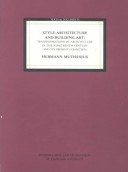This text attempts to define the elements of early modernist architecture according to notions of realism and simplicity. Although the author, Hermann Muthesius, is perhaps most well-known in Anglo-American architectural literature for his studies of the English house, his work constituted a wide-ranging modernist polemic emanating from the German realist movement of the late 1890s. Notions introduced in the book became common in later modernist historiography: disdain for the 19th century's artistic eclecticism and lack of originality; appreciation of the material and industrial aspects of building technology; and a simpler approach to design. Muthesius' critique of stylistic architecture is not only linked to the development of the Deutsche Werkbund movement, but also can be viewed more broadly as a cornerstone of the modern movement. The introduction by Standford Anderson situates Muthesius and his work in turn-of-the-century architectural discourse and analyzes his vision of a new form of architecture.
Anderson also discusses the rationale underlying the call for cultural renewal, the role of English architectural models in Muthesius's thought, critical differences between the first and second editions of "Style-Architecture and Building-Art", the influence of the Jugendstil and art nouveau movements on Muthesius and, in turn, the influence of Muthesius on the Deutsche Werkbund movement.
- ISBN10 0892362820
- ISBN13 9780892362820
- Publish Date 25 July 1996
- Publish Status Out of Print
- Out of Print 29 June 2010
- Publish Country US
- Publisher Getty Trust Publications
- Imprint Getty Research Institute,U.S.
- Format Hardcover
- Pages 208
- Language English
